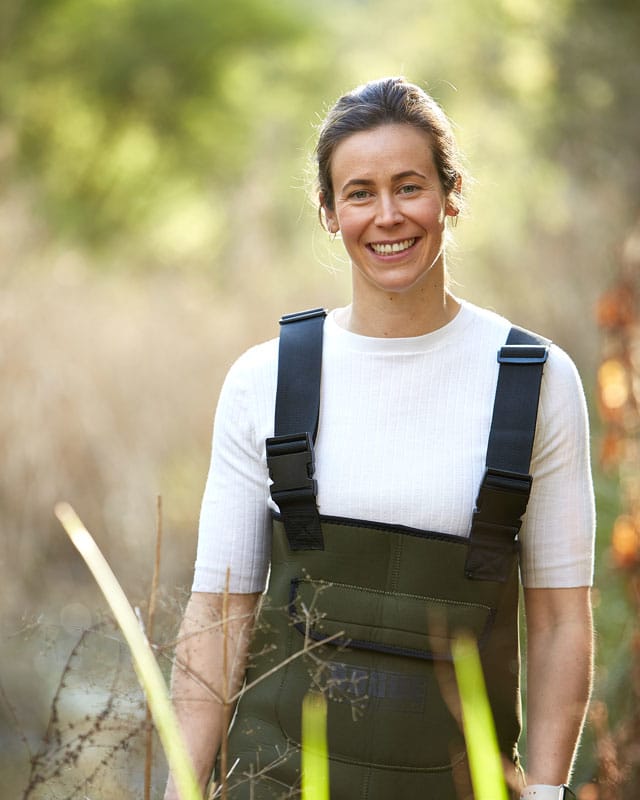Protecting our waterways from drugs and microplastics
Traces of drugs are increasingly being detected in waterways, and Dr Erinn Richmond is studying the potential harm posed to ecological environments and whether microplastics aid the transportation of drugs into the diets of aquatic creatures.
For Dr Erinn Richmond, aquatic environments are fascinating places. What began as childhood enjoyment holidaying along the Murray River morphed into concern during her bachelor’s degree as she developed a deeper understanding of human impacts on rivers and streams.
Today, that’s evolved into a research career dedicated to the protection of the aquatic life that call these waterways home, from tiny insects to fish, and even the iconic platypus.
Richmond has spent a significant portion of her academic career with Monash University, from an undergraduate degree in environmental science through to a PhD, and now as associate lecturer in the School of Biological Sciences.
She is continuing her research on pharmaceuticals in waterways, working with US and Swedish scientists to study whether microplastics aid the transportation of drugs into the diets of aquatic creatures.
Largely, pharmaceuticals leach into waterways through sewage treatment facilities or deteriorating sewerage infrastructure.
“The overarching question of the project is whether or not microplastics enhance the movement of pharmaceuticals in the aquatic food web,” she says.
The research team believes that organisms, such as insects or fish, living in and around streams could have an elevated exposure to pharmaceuticals through microplastics. This is because drugs adhere to plastic material, which is then carried into the organism. And this, she says, could potentially have a greater effect on the organism than if it was to take up pharmaceuticals through the water column or through a food source.
“The important thing to remember is, when we take a pharmaceutical, it’s designed to have an effect on us. Therefore, it’s not surprising that there are also potential consequences for aquatic life.”
Richmond says the researchers have learned that pharmaceuticals affect insects living in the aquatic environments and can speed up their life cycles.
The project builds on her past research, which found cocktails of contaminants, including medications, move through aquatic food webs – from insects to larger species that feed on them, including trout and platypuses. The contaminants can also influence ecosystem processes, such as the way algae produce and consume oxygen, which is vital to the health of the waterway and as a source of oxygen for other inhabitants.


“The important thing to remember is, when we take a pharmaceutical, it’s designed to have an effect on us. Therefore, it’s not surprising that there are also potential consequences for aquatic life,” Richmond points out.
Even at non-toxic levels, the entrance of drugs into aquatic environments is cause for concern. Long-term consequences are largely unknown, she says. “We’re still scratching the surface in terms of the myriad effects we can measure.”
Driving change
Richmond hopes her research will be used to educate and inform the public and policymakers about the potential harm of pharmaceuticals on freshwater environments.
It’s not so much about changing the way we take medications, she says, but rather increasing awareness about the way we dispose of them – ideally, returning unused pharmaceuticals to pharmacies for correct disposal rather than tipping them down the drain.
“It’s about making sure we inform the public about what not to do,” she says.
Humans are substantial drivers of global environmental change, and while our actions can cause harm, researchers can work together across disciplines to understand and address the effects on ecological systems and organisms, Richmond says.
“It will require us as ecologists to collaborate with other allied researchers [such as biochemists, pharmacologists and agricultural scientists] to achieve a common goal of environmental sustainability,” she says.
And it’s this comprehensive and well-rounded scientific evidence base that will help to inform and educate the global population and decision-makers. “With collaboration and an interdisciplinary approach, we can start to give science a compelling, driven voice ... We can be substantial, positive drivers of change on our environment and sustainability.”
Stem of inspiration
Richmond’s drive has been fuelled by a number of inspirational female scientists she’s encountered through her career. Chief among them is aquatic ecologist Dr Emma Rosi, her supervisor at the Cary Institute of Ecosystem Studies in New York, where she studied as part of her PhD.
“She taught me not to be afraid to have self-confidence,” Richmond recalls of her mentor and now close friend, with whom she’s collaborating on the microplastics and pharmaceuticals research.
Richmond counts herself lucky to have worked with “some very driven and successful female scientists”, and encourages others to seek out those who inspire them as they pursue STEM endeavours.
“Working with people who are enthusiastic, dedicated and highly successful – it’s contagious. My advice to younger women would be to surround yourself with people like that.”



